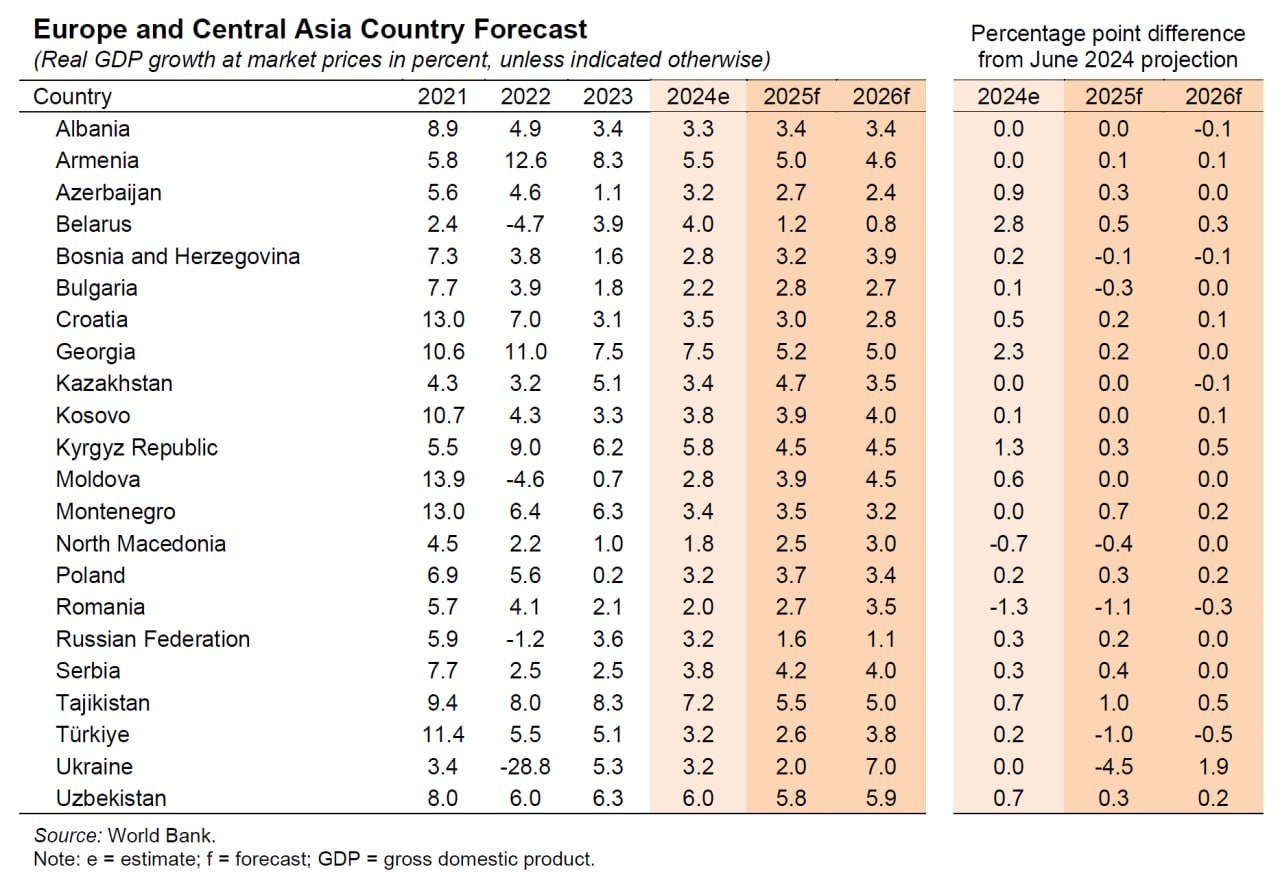
Uzbekistan is among the top three fastest-growing economies in Europe and Central Asia in 2024 — World Bank
🌐 Economic growth in the developing economies of the Europe and Central Asia region is stabilizing after a series of crises but at levels well below the early-2000s, says the World Bank’s Economic Update for the region, released today.
📊 Regional growth is expected to moderate to 3.3% this year from 3.5% in 2023, slowing further to 2.6% in 2025. This is significantly weaker than the 5.1% average growth of 2000-09.
⚠️ Countries of the Europe and Central Asia region have ably navigated the recent shocks of high inflation, the fallout from Russia’s invasion of Ukraine, and weak expansion in the European Union, the region’s key export market.
📈 Currently, economic growth in the developing economies of Europe and Central Asia is underpinned by private consumption because of rising wages, government transfers to households, and falling inflation.
💸 Remittance inflows are also above pre-pandemic levels, and they continue to support economic expansion in the Western Balkans, the South Caucasus, and Central Asia.
🏆 In 2024, among over 20 countries in the region, the highest GDP growth is observed in Georgia🇬🇪 (7.5%), Tajikistan🇹🇯 (7.2%), Uzbekistan🇺🇿 (6%), the Kyrgyz Republic🇰🇬 (5.8%), and Armenia🇦🇲 (5.5%).
🥇 Forecasts for 2025 indicate that Uzbekistan may become the leader in economic growth in the region, with an expected GDP increase of 5.8%.
🇺🇦 In Ukraine, substantial damage from Russia’s invasion and extensive electricity disruptions are likely to slow growth from 5.3% last year to 3.2% this year and 2% in 2025.
🇷🇺 In Russia, tighter monetary policy and increasingly binding constraints on production capacity and labor resources are expected to slow growth from 3.6% in 2023 to 3.2% this year and 1.6% in 2025.
🇹🇷 Growth in Türkiye, the region’s second largest economy after Russia, is set to slow to 3.2% this year, from 5.1% in 2023.
🎒 A special section of the report is dedicated to the role of human capital as a factor of economic growth in the countries of the Europe and Central Asia region. It is noted that to accelerate productivity growth in the long term, they need to significantly improve the quality of secondary and higher education.
🏫 The report notes that, across the region, enrollment rates at all levels of education are high. The problem lies with the quality of education, which has deteriorated in recent years. Test scores on the Program for International Student Assessment (PISA), which is administered to 15-year-old students, have declined substantially over the last decade.
🚧 Gaps in the quality of basic (primary and secondary) education are particularly large for students from disadvantaged backgrounds. Weaknesses in higher education systems include outdated curricula, lack of investment in equipment and infrastructure, poor management, and the disconnect between education and labor market needs.
🔎 Learn more: https://tinyurl.com/4cz93h2p
🌐 Economic growth in the developing economies of the Europe and Central Asia region is stabilizing after a series of crises but at levels well below the early-2000s, says the World Bank’s Economic Update for the region, released today.
📊 Regional growth is expected to moderate to 3.3% this year from 3.5% in 2023, slowing further to 2.6% in 2025. This is significantly weaker than the 5.1% average growth of 2000-09.
⚠️ Countries of the Europe and Central Asia region have ably navigated the recent shocks of high inflation, the fallout from Russia’s invasion of Ukraine, and weak expansion in the European Union, the region’s key export market.
📈 Currently, economic growth in the developing economies of Europe and Central Asia is underpinned by private consumption because of rising wages, government transfers to households, and falling inflation.
💸 Remittance inflows are also above pre-pandemic levels, and they continue to support economic expansion in the Western Balkans, the South Caucasus, and Central Asia.
🏆 In 2024, among over 20 countries in the region, the highest GDP growth is observed in Georgia🇬🇪 (7.5%), Tajikistan🇹🇯 (7.2%), Uzbekistan🇺🇿 (6%), the Kyrgyz Republic🇰🇬 (5.8%), and Armenia🇦🇲 (5.5%).
🥇 Forecasts for 2025 indicate that Uzbekistan may become the leader in economic growth in the region, with an expected GDP increase of 5.8%.
🇺🇦 In Ukraine, substantial damage from Russia’s invasion and extensive electricity disruptions are likely to slow growth from 5.3% last year to 3.2% this year and 2% in 2025.
🇷🇺 In Russia, tighter monetary policy and increasingly binding constraints on production capacity and labor resources are expected to slow growth from 3.6% in 2023 to 3.2% this year and 1.6% in 2025.
🇹🇷 Growth in Türkiye, the region’s second largest economy after Russia, is set to slow to 3.2% this year, from 5.1% in 2023.
🎒 A special section of the report is dedicated to the role of human capital as a factor of economic growth in the countries of the Europe and Central Asia region. It is noted that to accelerate productivity growth in the long term, they need to significantly improve the quality of secondary and higher education.
🏫 The report notes that, across the region, enrollment rates at all levels of education are high. The problem lies with the quality of education, which has deteriorated in recent years. Test scores on the Program for International Student Assessment (PISA), which is administered to 15-year-old students, have declined substantially over the last decade.
🚧 Gaps in the quality of basic (primary and secondary) education are particularly large for students from disadvantaged backgrounds. Weaknesses in higher education systems include outdated curricula, lack of investment in equipment and infrastructure, poor management, and the disconnect between education and labor market needs.
🔎 Learn more: https://tinyurl.com/4cz93h2p
